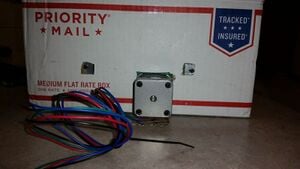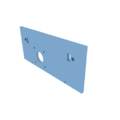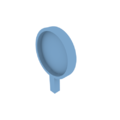Robertarden (talk | contribs) No edit summary |
(Categorize based on keywords) |
||
| (59 intermediate revisions by 9 users not shown) | |||
| Line 1: | Line 1: | ||
[[File:Monochromator Front.jpg|thumb]] | |||
[[File: | |||
{{Project data | |||
| authors = User:Robertarden, User:Mikehartl, User:Akhenry, User:Michaelpatrick | |||
| completed = 2015 | |||
| made = Yes | |||
| replicated = No | |||
| cost = USD 100 | |||
}} | |||
Monochromators are used in optics to isolate certain wavelengths from a light source made up of many wavelengths.<ref>Monochromator Wikipedia [https://en.wikipedia.org/wiki/Monochromator]</ref> Monochromators on the market are anywhere from $2000 to $10,000. Our monochromator is made for less than $100. | |||
Monochromators are used in optics to isolate certain wavelengths from a light source made up of many wavelengths. <ref> Monochromator Wikipedia [https://en.wikipedia.org/wiki/Monochromator]</ref> Monochromators on the market are anywhere from $2000 to $10,000. Our monochromator is made for less than $100. | |||
== Project goals == | == Project goals == | ||
| Line 18: | Line 17: | ||
== Design == | == Design == | ||
<!-- Monochromator Parts | <!-- Monochromator Parts --> | ||
<gallery caption="Monochromator Parts"> | <gallery caption="Monochromator Parts"> | ||
File:Monochromator_Wall.png|Monochromator Wall | File:Monochromator_Wall.png|Monochromator Wall | ||
File:Monochromator_Mirror_Holder.png|Monochromator Base Plate | File:Monochromator_Mirror_Holder.png|Monochromator Base Plate | ||
File: | File:Monochromator_CD.jpg|View of diffraction grating | ||
File:Monochromator_Mirrors.jpg|View of concave mirrors | |||
File:Monochromator_Front.jpg|View of enclosure front | |||
File:Monochromator_Top.jpg|Top view of monochromator | |||
</gallery> | </gallery> | ||
===Mechanical Assembly Instructions=== | === Mechanical Assembly Instructions === | ||
#Purchase mirrors, bolts, nuts, razor blades, stepper motor, and associated electronics | |||
#Print files from NIH site http://3dprint.nih.gov/discover/3dpx-002158 | # Purchase mirrors, bolts, nuts, razor blades, stepper motor, and associated electronics | ||
#Epoxy mirrors into printed mirror holders and leave until dry | # Print files from NIH site http://3dprint.nih.gov/discover/3dpx-002158 | ||
#Cut 1" by 1" square from edge of DVD-R and epoxy to mirror holder face | # Epoxy mirrors into printed mirror holders and leave until dry | ||
#Epoxy 16mm M3 bolt onto end of stepper motor | # Cut 1" by 1" square from edge of DVD-R and epoxy to mirror holder face | ||
#Push M3 nuts into pockets on back of front wall | # Epoxy 16mm M3 bolt onto end of stepper motor | ||
#Bolt razor blades onto wall with sharp edge pointed into center of wall | # Push M3 nuts into pockets on back of front wall | ||
#Bolt stepper motor to wall using 4 bolts, with 2 washers under each bolt | # Bolt razor blades onto wall with sharp edge pointed into center of wall | ||
#Bolt wall to base with 2 M3 bolts | # Bolt stepper motor to wall using 4 bolts, with 2 washers under each bolt | ||
#Push first mirror holder into square slot on base pointed toward front wall and insert bolt from underneath to secure, repeat with second mirror holder | # Bolt wall to base with 2 M3 bolts | ||
#Push M3 nut into pin for diffraction grating mount | # Push first mirror holder into square slot on base pointed toward front wall and insert bolt from underneath to secure, repeat with second mirror holder | ||
#Place pin into arms on diffraction grating mount | # Push M3 nut into pin for diffraction grating mount | ||
#Place diffraction grating mount into hole on base plate | # Place pin into arms on diffraction grating mount | ||
#Rotate pin so that the nut side is closest to the stepper motor and rotate the motor by hand to start the bolt into the nut | # Place diffraction grating mount into hole on base plate | ||
# Rotate pin so that the nut side is closest to the stepper motor and rotate the motor by hand to start the bolt into the nut | |||
# Place assembly into cardboard box, mark out holes for motor and slots | |||
# Remove assembly, cut out holes, place assembly back in box | |||
# Tape assembly to bottom and front of box being careful to not cover inlet and outlet slots with tape | |||
# Proceed to electrical setup section | |||
=== Electrical Assembly Instructions / Software === | |||
# Wire stepper motor according to [http://fritzing.org/media/fritzing-repo/projects/a/a4988-single-stepper-test/images/Arduino%20A4988%20Single%20Stepper%20Wiring_bb.jpg this] diagram<ref>http://fritzing.org/projects/a4988-single-stepper-test/</ref> | |||
# Program Arduino according to the code below: | |||
<nowiki>#</nowiki>include <Stepper.h> | |||
const int stepsPerRevolution = 200; // change this to fit the number of steps per revolution | |||
// for your motor | |||
// initialize the stepper library on pins 8 through 11: | |||
//Stepper myStepper(stepsPerRevolution, 4, 5); | |||
int stepCount = 0; // number of steps the motor has taken | |||
void setup() { | |||
pinMode(6,OUTPUT); // Enable | |||
pinMode(5,OUTPUT); // Step | |||
pinMode(4,OUTPUT); // Dir | |||
// initialize the serial port: | |||
Serial.begin(9600); | |||
} | |||
=== | void loop() { | ||
// step one step: | |||
Serial.println("Please Enter Step Value (-50 to 50): "); | |||
while (Serial.available() == 0); | |||
int val = Serial.parseInt(); //read int or parseFloat for ..float... | |||
if(abs(val) > 50) { | |||
Serial.println("ERROR: Too High of Input Value."); | |||
goto failed; | |||
} | |||
if(val < 0) { | |||
digitalWrite(4,HIGH); // Set Dir high | |||
} | |||
else { | |||
digitalWrite(4,LOW); // Set Dir low | |||
} | |||
for(int i = 0; i < abs(val); i++) { | |||
digitalWrite(5,HIGH); // Output high | |||
delayMicroseconds(500); // Wait 1/2 a ms | |||
digitalWrite(5,LOW); // Output low | |||
delayMicroseconds(500); // Wait 1/2 a ms | |||
} | |||
Serial.print("Moved "); | |||
Serial.print(val); | |||
Serial.println(" Steps."); | |||
stepCount++; | |||
failed:; | |||
//delay(500); | |||
} | |||
=== Calibration === | |||
# Due to the many types of mirrors and DVDs available calibration is recommended | |||
# Acquire a white light source and spectrometer | |||
# Move the mirror to the maximum and minimum travel and record the prevalent wavelength | |||
# Take additional points if necessary at known number of stepper motor rotations | |||
# Use either a best fit linear line or polynomial to calculate wavelength output vs stepper motor rotations | |||
== Costs == | == Costs == | ||
{| class="wikitable" | {| class="wikitable" | ||
! Item | ! Item | ||
! Quantity | ! Quantity | ||
| Line 61: | Line 122: | ||
| 50 mm dia, 100 mm focal length Concave Mirrors | | 50 mm dia, 100 mm focal length Concave Mirrors | ||
| 2 | | 2 | ||
| | | $10 | ||
|- | |- | ||
| Razor Blades | | Razor Blades | ||
| Line 86: | Line 147: | ||
| 1 | | 1 | ||
| $20 | | $20 | ||
|- | |||
| Breadboard | |||
| 1 | |||
| $8 | |||
|} | |} | ||
| Line 92: | Line 157: | ||
=== Current Issues === | === Current Issues === | ||
#Diffraction mount will not actually rotate in current configuration | # Diffraction mount will not actually rotate in current configuration | ||
#Setup in now too heavy on motor side | # Setup in now too heavy on motor side | ||
#Motor is also in the way of light openings | # Motor is also in the way of light openings | ||
== | === Possible Solutions === | ||
# For all problems above move motor underneath and direct mount to diffraction mount | |||
== References == | == References == | ||
<!-- This code is for placing the citation you included above. | <!-- This code is for placing the citation you included above. If you did not use the<ref>code, please delete this. --> | ||
<references/> | <references /> | ||
== Contact details == | == Contact details == | ||
#[[User:robertarden|Robert Arden]] | # [[User:robertarden|Robert Arden]] | ||
#[[User:Mikehartl|Mike Hartl]] | # [[User:Mikehartl|Mike Hartl]] | ||
#[[User:Michaelpatrick|Michael Patrick]] | # [[User:Michaelpatrick|Michael Patrick]] | ||
#[[User:Akhenry|Andrea Henry]] | # [[User:Akhenry|Andrea Henry]] | ||
{{Page data | |||
| keywords = 3D printing, arduino, monochromator, optics | |||
| sdg = SDG08 Decent work and economic growth, SDG09 Industry innovation and infrastructure | |||
| published = 2015 | |||
| license = CC-BY-SA-3.0 | |||
| language = en | |||
}} | |||
[[Category:3D printing]] | |||
[[Category:Optics]] | |||
[[Category: | |||
Latest revision as of 13:55, 23 October 2023

Monochromators are used in optics to isolate certain wavelengths from a light source made up of many wavelengths.[1] Monochromators on the market are anywhere from $2000 to $10,000. Our monochromator is made for less than $100.
Project goals[edit | edit source]
The goal for this project was to create an easily 3D printed and assembled monochromator that is still relatively accurate.
Design[edit | edit source]
- Monochromator Parts
-
Monochromator Wall
-
Monochromator Base Plate
-
View of diffraction grating
-
View of concave mirrors
-
View of enclosure front
-
Top view of monochromator
Mechanical Assembly Instructions[edit | edit source]
- Purchase mirrors, bolts, nuts, razor blades, stepper motor, and associated electronics
- Print files from NIH site http://3dprint.nih.gov/discover/3dpx-002158
- Epoxy mirrors into printed mirror holders and leave until dry
- Cut 1" by 1" square from edge of DVD-R and epoxy to mirror holder face
- Epoxy 16mm M3 bolt onto end of stepper motor
- Push M3 nuts into pockets on back of front wall
- Bolt razor blades onto wall with sharp edge pointed into center of wall
- Bolt stepper motor to wall using 4 bolts, with 2 washers under each bolt
- Bolt wall to base with 2 M3 bolts
- Push first mirror holder into square slot on base pointed toward front wall and insert bolt from underneath to secure, repeat with second mirror holder
- Push M3 nut into pin for diffraction grating mount
- Place pin into arms on diffraction grating mount
- Place diffraction grating mount into hole on base plate
- Rotate pin so that the nut side is closest to the stepper motor and rotate the motor by hand to start the bolt into the nut
- Place assembly into cardboard box, mark out holes for motor and slots
- Remove assembly, cut out holes, place assembly back in box
- Tape assembly to bottom and front of box being careful to not cover inlet and outlet slots with tape
- Proceed to electrical setup section
Electrical Assembly Instructions / Software[edit | edit source]
#include <Stepper.h>
const int stepsPerRevolution = 200; // change this to fit the number of steps per revolution // for your motor
// initialize the stepper library on pins 8 through 11: //Stepper myStepper(stepsPerRevolution, 4, 5);
int stepCount = 0; // number of steps the motor has taken
void setup() {
pinMode(6,OUTPUT); // Enable
pinMode(5,OUTPUT); // Step
pinMode(4,OUTPUT); // Dir
// initialize the serial port: Serial.begin(9600); }
void loop() {
// step one step:
Serial.println("Please Enter Step Value (-50 to 50): ");
while (Serial.available() == 0);
int val = Serial.parseInt(); //read int or parseFloat for ..float...
if(abs(val) > 50) {
Serial.println("ERROR: Too High of Input Value.");
goto failed;
}
if(val < 0) {
digitalWrite(4,HIGH); // Set Dir high
}
else {
digitalWrite(4,LOW); // Set Dir low
}
for(int i = 0; i < abs(val); i++) {
digitalWrite(5,HIGH); // Output high
delayMicroseconds(500); // Wait 1/2 a ms
digitalWrite(5,LOW); // Output low
delayMicroseconds(500); // Wait 1/2 a ms
}
Serial.print("Moved ");
Serial.print(val);
Serial.println(" Steps.");
stepCount++;
failed:;
//delay(500);
}
Calibration[edit | edit source]
- Due to the many types of mirrors and DVDs available calibration is recommended
- Acquire a white light source and spectrometer
- Move the mirror to the maximum and minimum travel and record the prevalent wavelength
- Take additional points if necessary at known number of stepper motor rotations
- Use either a best fit linear line or polynomial to calculate wavelength output vs stepper motor rotations
Costs[edit | edit source]
| Item | Quantity | Approximate Cost |
|---|---|---|
| Plastic | 163 g at 25% fill | $3.75 |
| 50 mm dia, 100 mm focal length Concave Mirrors | 2 | $10 |
| Razor Blades | 2 | $1 |
| NEMA 17 Stepper Motor | 1 | $20 |
| M3x0.5 10 mm bolts | 8 | $4 |
| M3x0.5 nuts | 3 | $2 |
| Arduino | 1 | $20 |
| Stepper Motor Driver | 1 | $20 |
| Breadboard | 1 | $8 |
Discussion[edit | edit source]
Current Issues[edit | edit source]
- Diffraction mount will not actually rotate in current configuration
- Setup in now too heavy on motor side
- Motor is also in the way of light openings
Possible Solutions[edit | edit source]
- For all problems above move motor underneath and direct mount to diffraction mount
References[edit | edit source]
- ↑ Monochromator Wikipedia [1]
- ↑ http://fritzing.org/projects/a4988-single-stepper-test/





